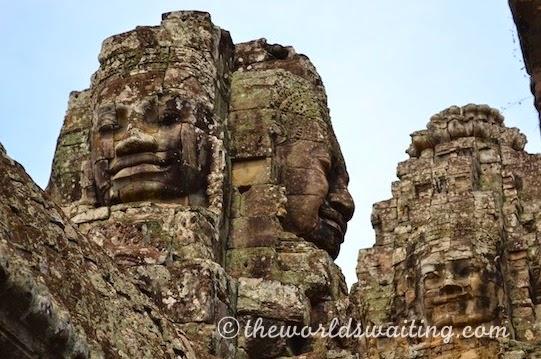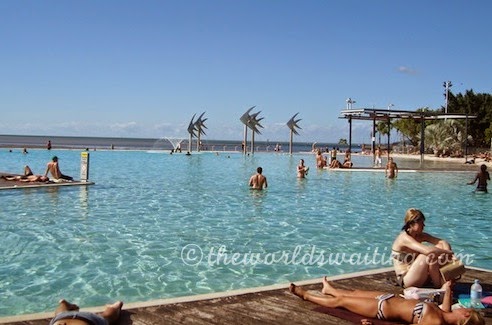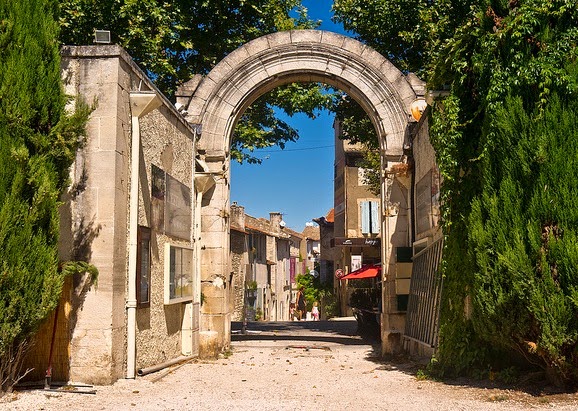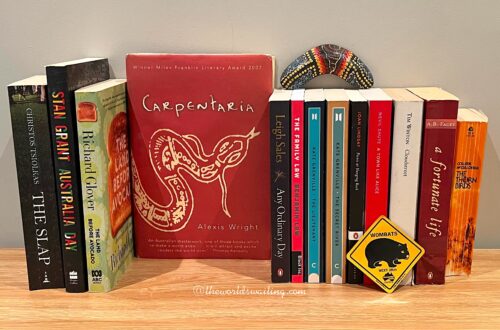
Angkor Thom – An Ancient city in ruins
While Angkor Wat is the most famous of the ancient ruins at Angkor, there is also an enormous historical city. Featuring a royal palace, a Buddhist temple, the terrace of elephants, four impressive gateways and incredible bas-relief carvings, Angkor Thom is not to be missed. It was our first day exploring Angkor and we started with a big day. Angkor Thom is the largest of all the areas of the ancient Angkor sites, and in many ways, the most interesting. King Jayavarman VII built Angkor Thom in the late 1100s and parts of the area were developed, rather than constructed new, indicating the historic significance of the site.

Angkor Thom Gate
Even before arriving at any constructions we enjoyed crossing the moat around the ancient city. The bridge was lined with statues on either side, each holding Naga, the snake god, who formed a balustrade. The statues were in varying states of repair and disrepair, and formed a magnificent welcome. The much-photographed gate was also impressive in its carving detail. It is only wide enough for a single vehicle to pass through at any time, so pedestrians beware!

As we passed through the gate a huge tree-lined boulevard opened up before us, leading to the heart of Angkor Thom. Beneath the trees monkeys sat on the grass watching as tourists purchased lotus roots from locals. They had the intention of politely feeding these to the monkeys, but the monkeys’ table manners are very different to those of the tourist. We watched one monkey climb up a woman to snatch the food before he made his escape!

Visiting Angkor Thom
The ancient city of Angkor Thom is vast. The walls surrounding the city are 12 kilometres long. It was the last capital city of the Khmer empire. King Jayarvarman’s state temple Bayon stands in the centre and is easily recognised because of all the benevolent faces carved into the stone. Near the entrance entire walls, about 2 metres high, are covered with intricate, and remarkably well-preserved, bas-relief carvings depicting historic battles.

Bayon
Buddhist temple Bayon is a three-tiered temple with 49 sanctuary towers on the second and third levels, each adorned with the faces of the gods. The principal Buddha statue was discovered in recent excavations and is now housed in a pavilion outside the temple.

Baphuon
Tall and imposing Baphuon is an impressive monument built in the form of a steep-sided pyramid. Baphuon makes clear the continuing construction in the area as it was discovered in the 11th century but also contains a statue of a reclining Buddha that was added during the 16th century, highlighting the transformation of these one-time Hindu temples to Buddhist sanctuaries.

Phimeanakas
Of the royal palace only Phimeanakas, which is believed to have been a place of worship, remains. The steep-sided structure is surrounded by statues of lions and has elephants on each corner. The area was surrounded by a five-metre-high stone wall, screening other buildings that have long since vanished.

The Elephant Terrace remains as a royal platform above a wide, open space where processions and festivals took place. It is so-called due to the stone carvings of elephants that line the platform structure, only a few of which are still recognisable as elephants today.

It took us an entire day to explore Angkor Thom and appreciate the details of the complex. While it is all in ruins today, it is easy to imagine how awe-inspiring Angkor Thom would have been when it was a living city. I loved the faces of the gods watching over the city and protecting it.

Have you ever been to a ruined city and imagined it in its heyday?




